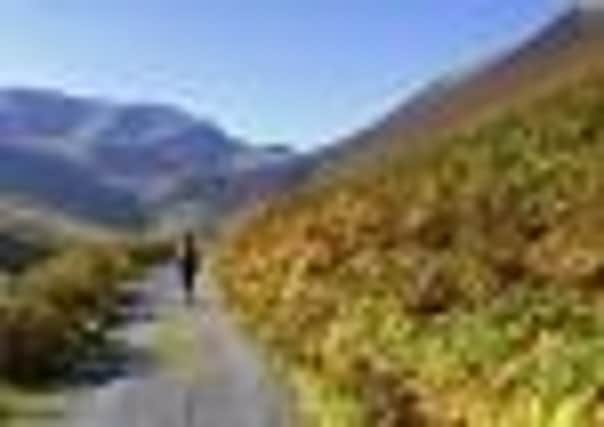Sex, fighting and moving on amid the mists and mellow fruitfulness


Golden fields wreathed in early-morning mist, bushes straining under the burden of swollen fruit, the nostalgic tang of wood smoke in the lengthening twilight – these sights and smells of autumn suggest the natural world is slowing its pace as it prepares to close the chapter on the fading year.
But rather than winding down, autumn – the season of “mists and mellow fruitfulness” – is one of the most dynamic periods of the year for our wildlife, charged with sex, fighting, epic migrations and a bonanza of food.
Advertisement
Hide AdAdvertisement
Hide AdIt is also arguably the most rewarding time to grab the walking boots and embrace the great outdoors. Temperatures are often warm but lacking the uncomfortable mugginess of summer, and the light can be startlingly clear, offering rewarding sunsets and sunrises.
And it is at this time of year that our wildlife seems to become visible again following the dog days of summer.
The National Trust has launched a series of strolls as part of its Great British Walk campaign, designed to celebrate the natural splendour of autumn.
From rutting deer to ripening fungi, these walks aim to bring us closer to the essence of this most dynamic of seasons.
Advertisement
Hide AdAdvertisement
Hide AdBut you don’t have to go far to witness the most blatant sign of autumn – just look up! You’ll see clusters of swallows feeding up before embarking on their epic migration to southern Africa.
Millions of birds are on the move; take a stroll along the tide line at coastal sites and witness the avian equivalent of Heathrow Airport.
Walks along coastal paths can reward with other less obvious migrations. Butterfly Conservation has reported a huge influx of immigrant, day-flying silver Y moths from the Continent – so called because of their telltale Y-like marking on the wing.
Other exotics are also drawn to our coasts, such as spectacular monarch butterflies from America; one specimen touching down in Dorset drew in more than a thousand onlookers.
Advertisement
Hide AdAdvertisement
Hide AdThese giant, orange butterflies are annual visitors each autumn, blown in following Atlantic storms mainly to the south coast.
Autumn is not solely about bidding farewell to our favourite species, as departing swallows are replaced by skeins of geese, decorating the crisp evening sky like abandoned musical notes.
These honking overlords fly in from the freezing North, their bugling calls a warning of the hard weather to come. A walk out to meres and salt marshes offers the perfect viewing point as squadrons of pink-footed, barnacle and brent geese touch down.
Autumn is spiced up with a fair helping of sex and violence and this is nowhere more evident than among the UK’s deer herds.
Advertisement
Hide AdAdvertisement
Hide AdBut it is also the quiet spectacles that delight. As day length shortens, our treescapes put on a mesmeric light show – leaves seep from endless shades of green to gold, russet and red.
Spotting the cartoonlike form of a crimson-topped fly agaric toadstool thrusting up through the leaf litter can transform a walk in the woods into a thrilling experience.
Peter Brash, animal ecologist for the National Trust, explains: “Autumn has always been the most exciting season for me. There’s a real feeling of abundance and activity in the natural world.
“The wonder of migration is under way with its maelstrom of the anticipated, the unexpected, the everyday and the rare.
Advertisement
Hide AdAdvertisement
Hide Ad“Birds soon to depart across the Sahara rub shoulders with those freshly arrived from Siberia in our berry-laden hedgerows or on the marshes and mudflats.
“It’s a time of great change, leaves morph into riotous colours before falling and fungi spring up overnight.
“The Great British Walk is a celebration of our national love affair with nature and walking.
“It’s all about how the joy of a walk through the countryside or a local park can lead to memories that will stay with you for a lifetime, as you come across an unexpected encounter or a moment that will be treasured forever.”
TOP NATIONAL TRUST AUTUMN WILDLIFE WALKS
Advertisement
Hide AdAdvertisement
Hide AdCoastal walks: A stroll along the coast at this time of the year can also reward with spectacular marine wildlife – the National Trust’s Walk at Treginnis at St David’s peninsula in Pembrokeshire, Wales, offers a good chance of catching up with seals and porpoises.
Deer rut: From the rutting reds of Richmond Park in London to the screaming sikas in Dorset, the X-rated spectacle can be experienced with relatively little difficulty. National Trust sites Castle Drogo in Devon, Ashbridge Estate in Buckinghamshire, Hatfield Forest in Essex, Attingham Park in Shropshire and Dunham Massey in Cheshire are all hosting deer walks during the rutting season.
Migrating birds: Blakeney National Nature reserve in Norfolk is a migrant hotspot. Join the trust’s warden to learn about species and migratory patterns.
Fungi foray: Trust experts will teach you what mushrooms to pick and what varieties you should leave well alone. Fungi feasts will be taking place at Gibside in Tyne and Wear, Dunwich Heath in Suffolk and May Hill in Gloucestershire.
contacts: For more information on the National Trust’s Great British Walk, visit www.nationaltrust.org.uk/greatbritishwalk